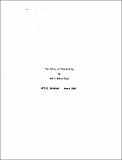The value of flexibility
Author(s)
Kulatilaka, Nalin
DownloadMIT-EL-86-014WP-19524140.pdf (1.444Mb)
Metadata
Show full item recordAbstract
This paper develops a framework to evaluate the economic
value derived from a firm's ability to switch between different
modes of production in the face of uncertain prices. The model,
cast as a set of simulataneous stochastic dynamic programs, is
solved for the ex-ante value of flexibility, the optimal
technology choice, and critical prices at which switching is
optimal.
This general model of flexibility is used to synthesize
several recent studies of real options encountered in capital
budgeting. For example, the model yields as special cases (a) the
value of waiting to invest, (b) the option to abandon, (c) the
value of having an option to shut down, (d) the replacement timing
and technology choice, and (e) the "time to build" option for
irreversible projects that require sequential outlays.
We use an illustrative example with two modes to show that
the value of flexibility is monotonically increasing with price
variability and switching frequency. The value of flexibility can
contribute about a 15 percent improvement over the better fixed
technology. Early in the life of the project it is optimal to
switch modes when the difference between values under one mode
(for the current period and optimal switching thereafter) and the
other mode exceeds the switching cost. Towards the end of the
economic life, the above difference must be significantly larger
for swithcing to occur.
Date issued
1986Publisher
MIT Energy Lab
Other identifiers
19524140
Series/Report no.
MIT-EL86-014WP